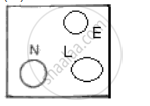Advertisements
Advertisements
प्रश्न
The diagram 31 shows a 3 terminal plug socket.
(i) What is the purpose of the terminal E?
(ii) To which part of the appliance is the terminal E connected?
(iii) To which wire L or N, is the fuse connected and why?

उत्तर
(i) The purpose of the terminal E is to provide earth connection.
(ii) Terminal E is connected to the earth pin of the plug.
(iii) Fuse is connected in series with the wire L, so that if excess current flows through the circuit, the fuse wire get heated up and melts thus, breaking the circuit and preventing the flow of current to the appliance.
APPEARS IN
संबंधित प्रश्न
An electric bulb is rated 220 V and 100 W. When it is operated on 110 V, the power consumed will be ______.
Water in an electric kettle connected to a 220 V supply took 5 minutes to reach its boiling point. How long would it have taken if the supply voltage had fallen to 200 V?
What is wrong with the circuit diagram (Fig. 34)? Carefully check the symbols and assign proper positive and negative signs to them.

State three factors on which the heat produced in a metallic wire due to passage of current in it depends.
How is the amount of heat produced calculated due to the passage of current in a metallic conductor? Derive an expression for it.
Establish the relation that heat produced in a metallic conductor due to the flow of current is V2t/R joules, where V is the potential difference across the ends of the conductor, R its resistance and t is the time in second for which current flows.
Find the heat produced in joules when a current of 10 amperes flows through a connecting wire of resistance 2 × 10-2 ohms and heating element of resistance 250 ohms for 2 seconds.
